 The Hong Kong International Numismatic Fair was supposed to take place from 13-15 July but had to be cancelled to keep in line with the government’s latest COVID-19 disease prevention measure. The fair is now scheduled to take place on 11-13 December 2020.
The Hong Kong International Numismatic Fair was supposed to take place from 13-15 July but had to be cancelled to keep in line with the government’s latest COVID-19 disease prevention measure. The fair is now scheduled to take place on 11-13 December 2020.
Heritage Auctions is in Hong Kong preparing to conduct their auction on 11-13 July 2020. If all goes well regarding relaxation of the coronavirus restrictions, they hope to conduct a floor-auction. If that is not possible, they will conduct an online auction.
In the meantime, pre-bidding via Internet will begin on 17 June onwards until the actual auction day where the Live Internet bidding will also take place.
Some very interesting Thai coins from the Dr. Norman Jacobs Collection will be auctioned. At the time of printing, only a preview was available on www.ha.com. No estimates are published so far, but I have put some estimates to the value of the coins. They could sell for more, which would make the consigners happy, or they could sell for less, making the buyers even happier.
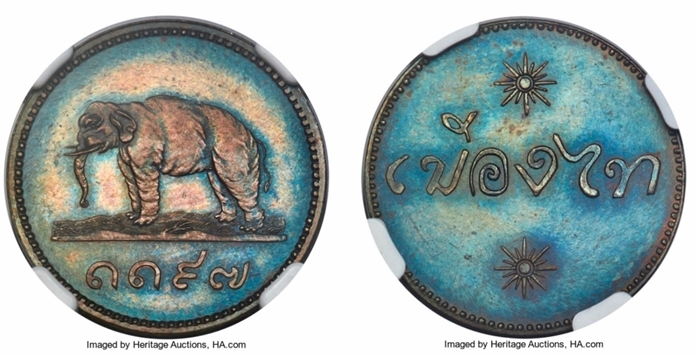
This ‘2 Keeping’ CS1197 (1835) is from the reign of Rama III. According to Ronachai Krisaladaolarn’s book “The Evolution of Thai Money” tokens were struck in two different designs, lotus flower and elephant. The Heaton Company in Birmingham struck the tokens. A theory is that Robert Hunter, an important British trader in Siam, ordered the tokens.
They were produced for trade with Singapore as a replacement for the bullet coins. King Nangklao, Rama III, rejected the tokens, of which 500 pieces were each struck. The one with the elephant is the most popular and it is offered in the auction. It is graded by NGC to be PR64. The buyer must probably spend some THB 300,000 to acquire this token considered by many to be the first flat Thai coin.
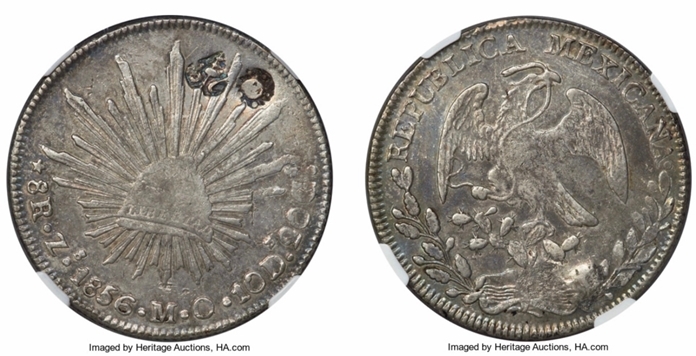
The production of bullet coins, ‘pot duang’ was very time-consuming. So to be able to have coins in circulation as soon as possible, the Siamese government countermarked the Mexican 8 Reales with the Mongkut (crown) and the Chakra (wheel) and were used as legal tender from 1858-1860.
At the auction there is only one piece dated 1856 graded by NGC to be VF35. These interesting coins are not often seen for sale, so it would not surprise me if the new owner must pay more than THB 200,000 for it even though the grade is not the very best.
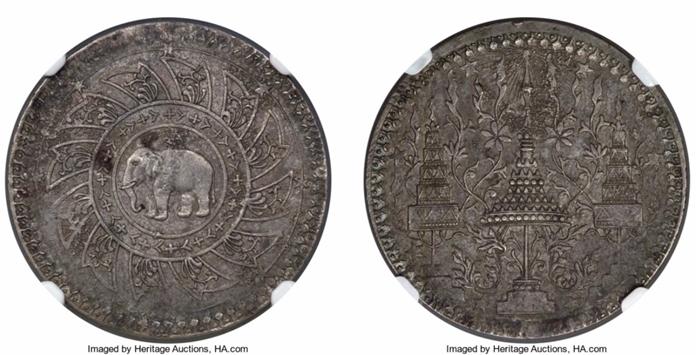
Queen Victoria presented King Mongkut, Rama IV, with a hand-driven minting machine. A One Baht coin was one of the coins produced in 1857-58 on this machine and referred to as Bannakarn, Royal Gift. The dies were produced in England and during the voyage became rusty. The imperfections can be distantly seen on the coins struck in Bangkok with these dies.
2,400 pieces of the One Baht Bannakarn coin were produced and circulated together with the One baht 1860, which were struck in large numbers on the steam-powered minting machine ordered from England. The difference between these two coins was undetected and stayed in circulation together throughout.
When the coins were taken out of circulation, the Bannakarn coins amongst them were also destroyed. Hence they are considered a rare coin and not easily found. The One Baht Bannakarn, Royal Gift, is graded by NGC to be AU55 and will probably sell for THB 150,000-200,000.
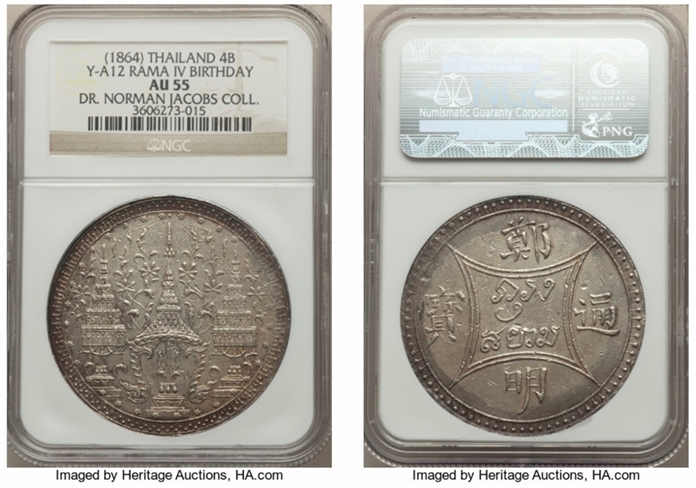
For King Mongkut, Rama IV’s 60th Birthday, a 4 Baht coin was struck in 1864, both in gold and silver. It is an impressive coin weighing 60.77 grams.
On the obverse of the 4 Baht coin, there is the Crown with rays flanked with umbrellas and three branches in the background, and bordered by 32 stars, each star representing one Fuang (1/8 Baht).
The reverse has the inscription, Krung Siam enclosed within a frame and the Chinese legend Cheng Ming Tung Pao outside the frame. “Cheng Ming” is the name of King Rama IV in Chinese and “Tung Pao” means “lawful money”. There are two types; one with the double-lined frame and dots around the rim, and the other with a single-lined frame without dots.
These coins were used for presentation purposes, and the King also permitted them to be used for decorations. The coin in the sale is in silver and graded by NGC to be AU55. The coin is not considered to be extremely rare but very popular and could sell for THB 600,000-800,000.
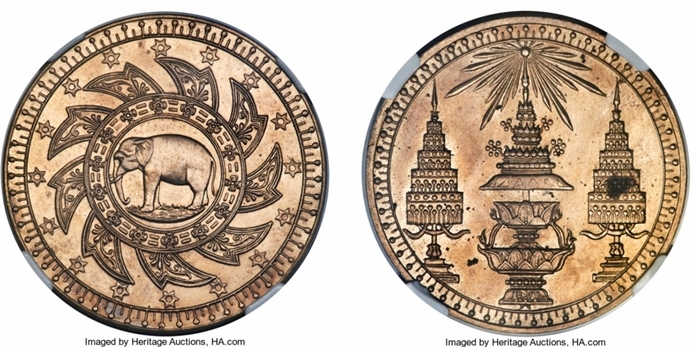
For King Chulalongkorn, Rama V, several patterns were produced. In the sale, a 2 Baht in nickel graded by NGC to be in MS63 is being offered. This is a very good grade, but patterns are normally seen in good condition as they were not intended for circulation. The larger patterns are more rare and popular and the buyer will probably be willing to pay about THB 500-700,000 for this pattern.
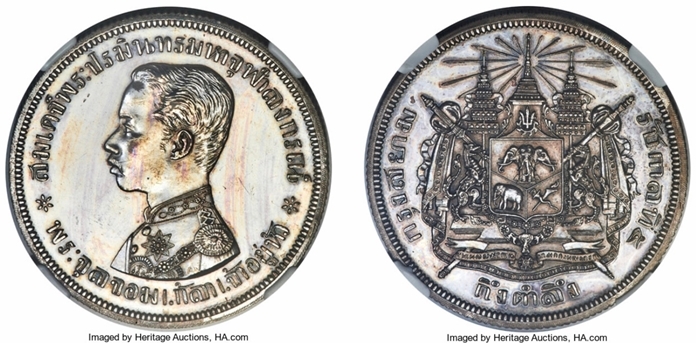
Royal portrait coins of King Chulalongkorn, Rama V are very popular. On the reverse is the Siamese Coat of Arms. A 2 Baht, ½ Tamlung, silver pattern in proof condition are being offered for sale. The 1-, ¼- and ⅛ Baht in proof are also rare but can be seen offered in the market from time to time.
For the three denominations in nice condition, one is expected to pay about THB 500,000-600,000. The two Baht coin, which was not put in circulation, was also produced in off metal strikes such as copper and white metal. The one in silver offered in the auction is extremely rare and popular. It is graded by NGC to be PR62 and will probably be the most expensive Thai coin in this sale. The price can reach THB 2.5-3 million.
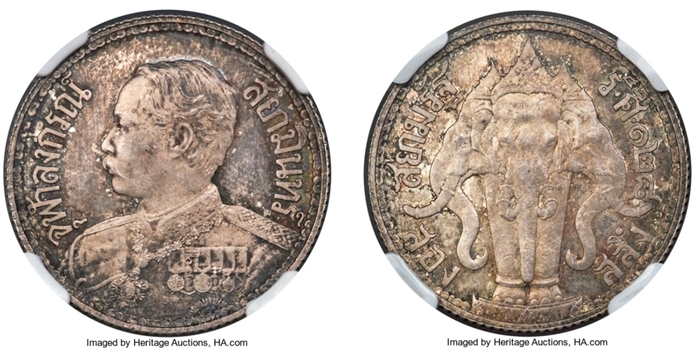
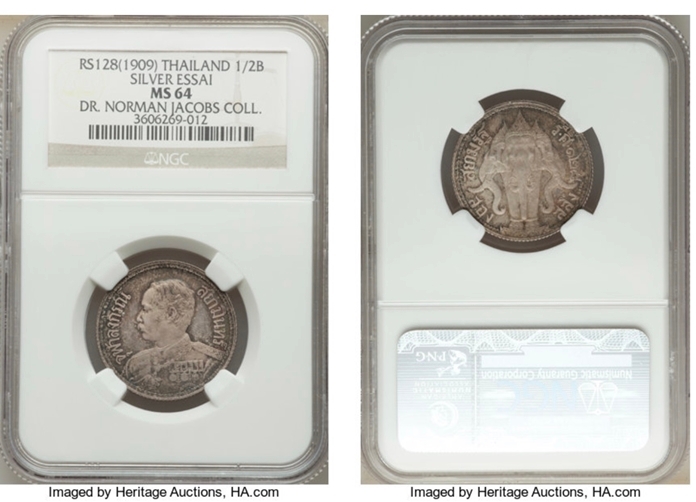
When King Chulalongkorn, Rama V, visited Paris during his second European journey, he paid a visit to the Paris Mint. The King modelled for the chief engraver of the Paris Mint Henri-August Patey and a 1 Baht coin was produced for circulation.
The 1 Baht coins dated RS 127 (1908) were never put in circulation because they arrived in Thailand after the King had passed away and were distributed at his cremation ceremony. The Essai Patterns of this popular coin were produced for the ¼-, ½ – and 1 Baht. All three denominations for the Essai are offered in the sale. The ½ Baht offered are dated 128 (1909) and is the rarest denomination of these coins.
The one offered in the sale is by NGC graded to be MS64. One of these ½ Baht coins was reportedly sold in Singapore at a Taisei auction in 1997 for US$23,000. Another of this rare coin was sold privately some time back. Probably the price in the Heritage auction will be more than THB 2 million.
Dr. Norman Jacobs’ was an active collector and researcher until he passed away in 2004. His collection includes coins from China, Japan, Korea and Thailand. In 2008, a part of Dr. Norman Jacobs’ collection was sold by Baldwin and Ma Tak Wo in Hong Kong for US$3,371,800. Since 2011 his Japanese and Korean coins were sold by Heritage in Long Beach, USA, for US$6.8 million. In the upcoming Hong Kong sale there will be 31 Thai rarities from Dr. Norman Jacobs’s collection up for sale.
More information and estimations can be found on www.ha.com/3084
 |
 |
 |





